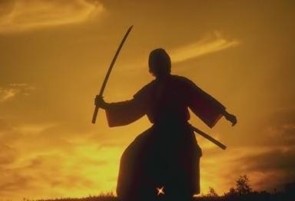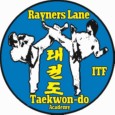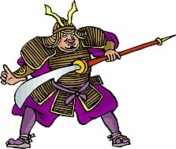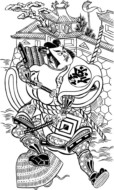

This is a true story from Japan which illustrates the ideal of warrior honour. It
is a classic example of how obligation, loyalty, revenge and suicide form into the Japanese cultural interpretation of warrior honour. This story involves a chain of events that begun in Edo (now Tokyo) during the Tokugawa Shogunate. The year was 1701, a hundred years after the Tokugawa Ieyasu had unified the country under his sword. His descendant, Tokugawa Tsunayoshi, now ruled the islands and ensured loyalty of the daimyo (warlords) by the institution of sankin kotai, or "alternate attendance." This law required all daimyo to maintain residences for their families in Edo and to spend every other year in the feudal capitol themselves. That way, the weak and paranoid bakufu administrators could ensure loyalty of the still rugged, rural daimyo by holding their families hostage. Asano Takumi no Kami was one such daimyo. Lord of the rural province of Ako, Asano was still a warrior in the truest sense. Unfortunately, he was young and impetuous, and his crude, martial manner didn't set well with the genteel sycophants who cluttered the shogun's court. When one of them insulted him, Asano drew his sword and attacked. Asano only managed to wound his enemy, Kira Kotzuke no Suke, but it was enough to cost him his life, for drawing a sword at court was a capital offence. For his lack of restraint, the shogun ordered Lord Asano to commit seppuka, ritual disembowelment. Asano was an obedient lord, and he ended his life later that day. This suddenly left Asano's retainers, the samurai of Ako, with two problems. First, they were without their master and unemployed. This was a bad situation, for under Tokugawa rule japan had been at peace almost a hundred years, and ronin (masterless samurai) had little chance of finding work. But more seriously, since their master had been condemned for breaking the shogun's law, all his retainers were honour-bound to follow him in seppuka. Most of them were ready to do this, for they were men of honour. But when they learned of how their lord had been duped into his fate by his enemy, Lord Kira, they knew they couldn't end their lives before taking care of business. All samurai were trained under the Confucian principle, " a man should not live under the same heaven with the murderer of his leader, lord or father." Of course, sepuka would have taken them out from under the same heaven as Kira, but the ronin of Ako saw their giri (obligation or debt) in this situation as something more than merely to join their master in death. They concluded they had a solemn duty to avenge the death of their lord. This would be no easy mission. All of Edo suspected the ronin would attempt some sort of attack, and Kira was under the shogun's protection. the bakufu had spies everywhere. Kira, a rich man with powerful friends, had a large security force as well. so meeting in secret, the men of Ako decided to play out a ruse until they convinced the eyes and ears of Edo they weren't a threat and attention on them tapered off. For the next two years, the 47 ronin of Ako went their separate ways. To the loathing amazement of Edo society, the men didn't attempt any revenge or even honour their fallen master in seppuka. They walked in disgrace, many taking up various non-warrior occupations. Some even left their families and became womanizers and drunks. In the eyes of the shogun, the other samurai, and even the commoners of Edo, these men had no honour and no face. It was all an act. By 1703 attention had shifted away from the degenerate ronin from Ako. So late one December night, the 47 faithful gathered one last time, then departed in a snowstorm for Kira's mansion. They caught the compound completely unprepared. In a surprise assault followed by a short skirmish, they killed Lord Kira and everyone in his household. Then, they took Kira's head, washed it in a nearby well, and placed it as an offering on Lord Asano's grave. That morning the 47 faithful ronin of Ako surrendered to bakufu authorities. Following fretful discussions with his councillors, the shogun sentenced them to death but ruled that they would be permitted to perform seppuka and die as warriors rather than face execution as common criminals. Within days all 47 joined their lord and entered the annals of history as Japanese national heroes. The story of the 47 ronin shows warrior (martial) honour in its purest form. They saw through the fog of law and recognised justice. They courageously fulfilled their obligations, knowing full well their actions would lead to their own destruction and they bore no illusions about the difference between honour and face (reputation within one's community). They publicly humiliated themselves for two years to fulfil their giri (obligation) to their master. |
GO TO |


SECTION 1 |
GO TO |
ARTICLES THE 47 FAITHFUL RONIN OF AKO |



We, the ronin serving Asano Takumi no Kami, this night will break into the mansion
of Kira Kotzuke no Suke to avenge our master. Please be assured that we are neither robbers nor ruffians and no harm will befall the neighbouring property. |
Placard the 47 ronin posted the night they avenged the death of their lord. |